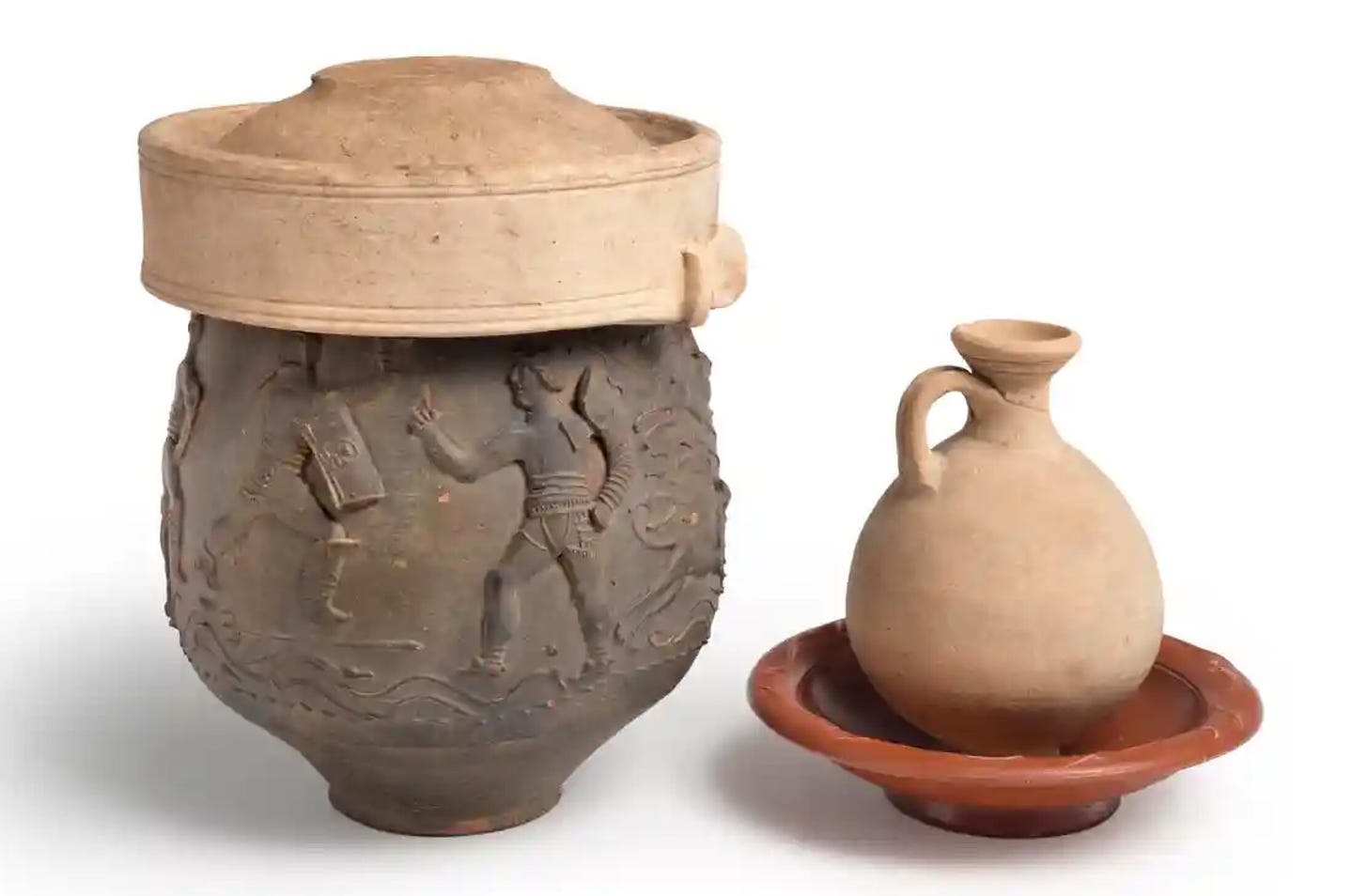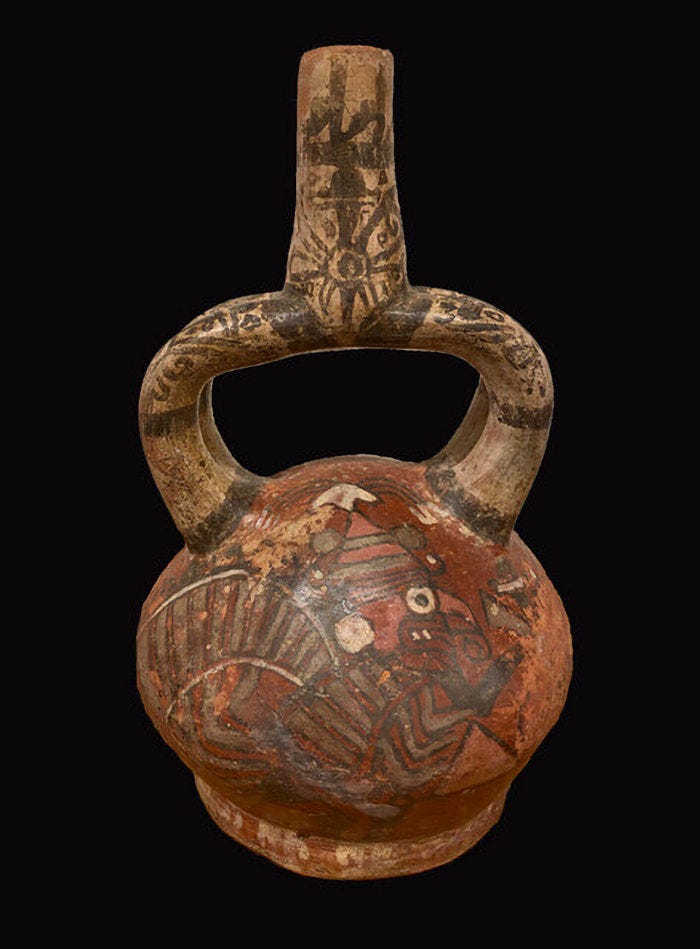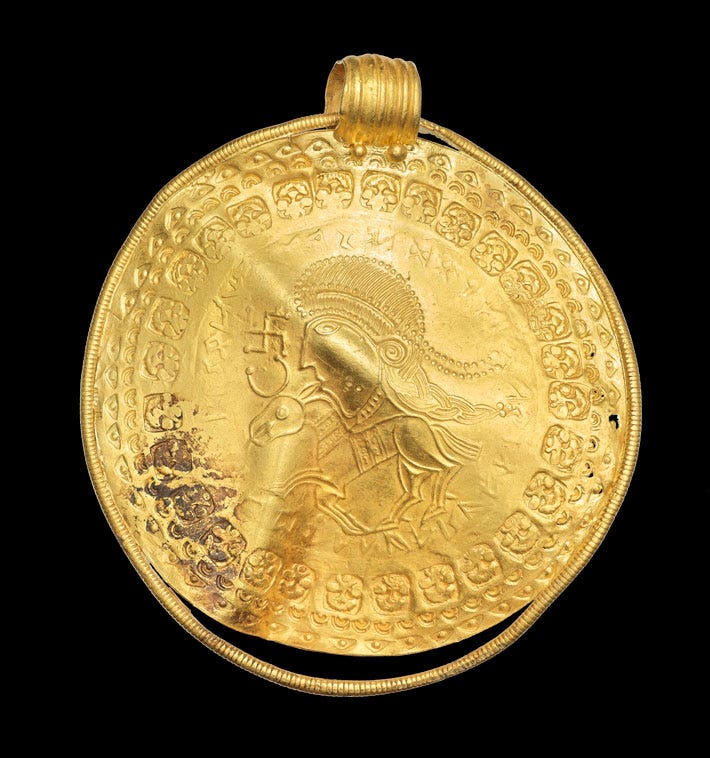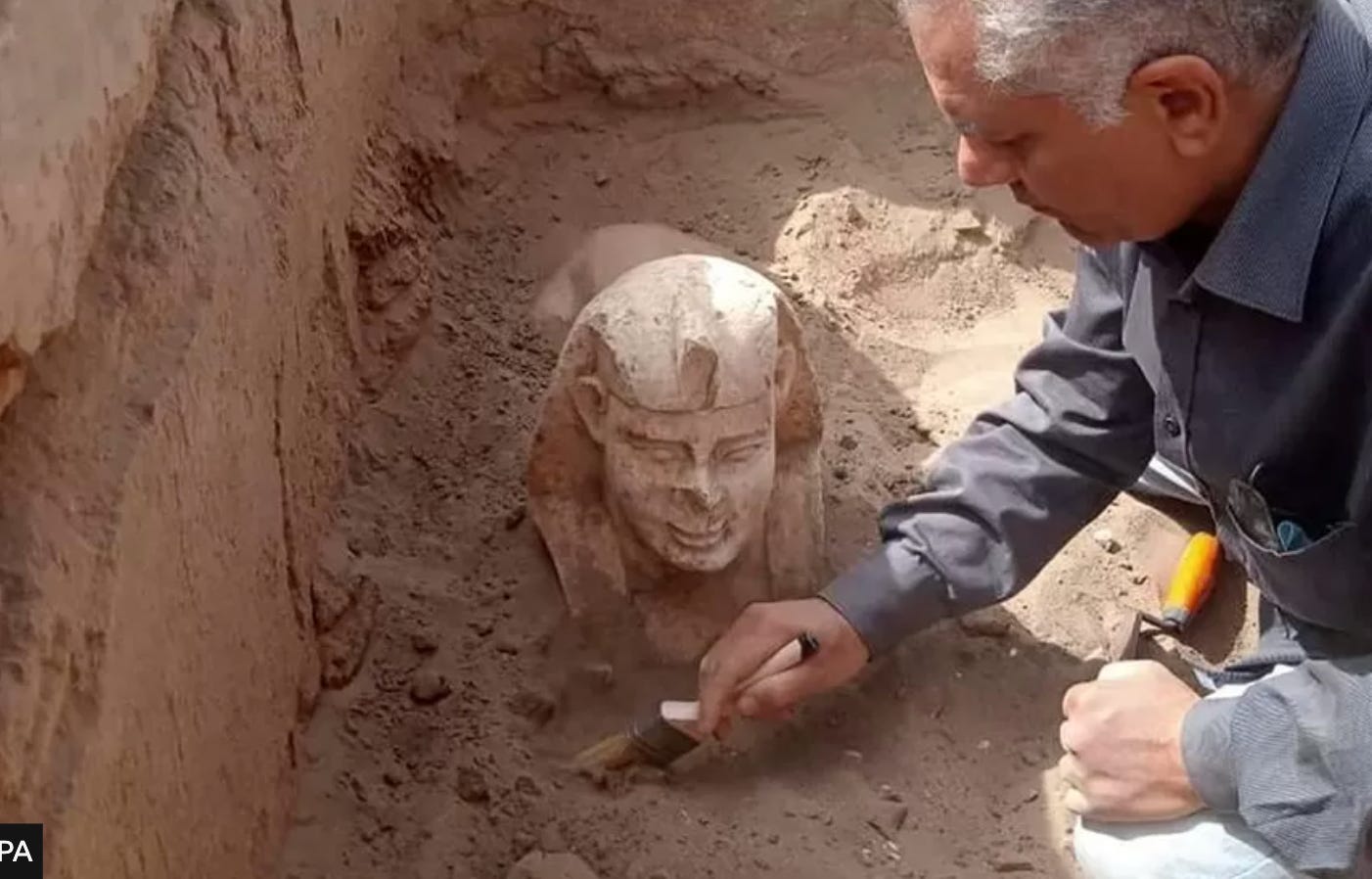🧐 Ancient Beat #51: Early horseback riding, Wari pigment propaganda, and the longevity of cities
Hi folks! Welcome to issue #51 of Ancient Beat. Before we get started, a quick (and pretty hilarious) retraction from last week’s issue:
I covered a potsherd that included the first inscription of Darius the Great ever found in Israel. Well, it turns out it wasn’t what it seemed. Apparently, an expert on Aramaic scripts was demonstrating to her students how sherds were inscribed. So she scratched this into an existing sherd at the site, then left it behind. Lo and behold, a hiker “discovered” it not long after and everyone went nuts. 😂 The Israel Antiquities Authority has issued a statement taking responsibility for the muck-up. No word on just how bummed that hiker is right now.
Ok, ready to learn cool things? Let’s dive right into the latest ancient news. 👇
🗞 Ancient News: Top 5
Archaeologists Find Evidence that Horseback Riding Began at Least 5,000 Years Ago — The earliest direct evidence of horseback riding was discovered in central Europe, indicating that the practice dates to at least 5000 years ago. Researchers examined 200 Bronze-Age skeletal remains looking for signs of riding, including telltale marks on hip sockets, thigh bones, and the pelvis. Of the 200 individuals, five were likely riders. These riders apparently belonged to a people called the Yamnaya, a fascinating culture that you might remember me touching on in issues #27 and #48. According to Alan Outram, “There is earlier evidence for harnessing and milking of horses, but this is the earliest direct evidence so far for horseback riding.” The researchers note that the Yamnaya were responsible for the spread of Indo-European languages and “reshap[ing] the genetic makeup of Europe” — horseback riding likely had a big impact on both. But it’s important to note that very few of the Yamnaya actually rode.
Archaeological Study Reveals that Collective Forms of Governance, Infrastructural Investments, and Collaboration All Help Societies Last Longer — A new study examined 24 ancient cities in Mexico to understand what helped certain cities to last longer than others. The researchers looked at a number of data points, from public architecture to economies to how rulers were depicted (hint: rulers depicted as larger-than-life were usually despotic societies while leaders who were masked or depicted in groups tended to share power). It turns out that the longest-lasting cities showed signs of collective forms of governance as opposed to autocracies and despotic societies. They also showed signs of infrastructural investments (e.g. central open plazas) and cooperation between households (e.g interconnected residential spaces) early on.
‘Startling’ New Evidence Reveals Gladiators Fought in Roman Britain — A vase from the 2nd century CE that depicts gladiatorial combat was discovered in Colchester, England in 1853. New analysis shows that it was made of local clay and the inscription bearing the names of two gladiators was added before firing rather than afterward as had originally been assumed. This indicates that the names were part of the original design, so it was not created as a generic representation of gladiators. Therefore, the researchers reason that the event likely took place in Colchester. According to Frank Hargrave, “It’s the only evidence of a Roman arena gladiator combat actually being staged in Britain. There are no written descriptions. The vase is such high quality that there’s been a bit of snobbery, an assumption that it couldn’t possibly have come from Britain, whereas all the analysis has now put that to bed.” The vase shares the story of two gladiators — the winner bears a name that indicates that he was likely from Africa. The owner of the vase who, for one reason or another, chose to commemorate the fight, was later buried with it.
Colors on these Ancient Pots Hint at the Power of an Empire — A new study compared the colors of ancient Peruvian potsherds and found that the Wari empire used a distinctive black pigment for ceramics that were used in rituals. The exact formulation of the pigment varied slightly, but overall, it was very similar from site to site, indicating that there was a “correct” black pigment that the Wari wanted everyone to use. The researchers take this as a sign of the empire’s influence. Some sites even had different recipes for black pigments which were then changed when the Wari came into power. Interestingly, though, what was depicted with the pigment varied from place to place. According to Muro Ynoñán, “In general in the Andean region, the color black is related to the ancestors, to the night, to the passage of time. In Wari times, the color was likely important for imposing a specific Wari ideology to the communities they conquered.” I covered the Wari culture briefly in the previous issue, and interestingly, that story was also about the empire’s influence.
Early Reference to Norse God Identified on Gold Disc in Denmark — A runologist has discovered the first known reference to the Norse god, Odin, providing the first solid piece of evidence that Odin was worshipped at least as early as the 5th century CE. It is on an ornamental pendant known as a bracteate which shows the face of a man on it. Above the man, the runes apparently say, “He is Odin’s man.” The bracteate was part of the 1,500-year-old Vindelev hoard that was found in Denmark in 2020.
That’s it for the free Top 5! If you’re a free subscriber, sign up for the paid plan for another 16 stories and 6 recommended pieces of content covering runes, a smiling sphinx, a Romano-Celtic temple, buried treasure, grape domestication, Neanderthal migration, whether or not the agricultural revolution was in our best interest, and much more.
(And if you want access but it’s a little too steep for you right now, just shoot me an email. 😃)
🗞 Ancient News: Deep Dive
Runes Were Just As Advanced As Roman Alphabet Writing — Medieval inscriptions in Norway include both runes and the Roman alphabet. According to Johan Bollaert, runes are generally thought to be part of a more oral (and less learned) tradition than Latin. The reason for this, according to his study, is that runic inscriptions are contextually bound. And it may also be due to runic inscriptions being compared to Latin manuscripts, which have completely different forms and functions, making the comparison misleading. Regardless, this notion of Latin being more learned is being challenged by the study. Apparently, both types of inscription feature the same amount of visual elements such as punctuation, carefully planned layouts, and ornamentation. According to Johan Bollaert, “…visual aspects are so important in written language. An inscription that has detailed punctuation, a carefully planned layout, and ornamentation shows better use of the writing's visual possibilities than a text without punctuation and spaces.” In addition to finding runes to be on par with letters, he found that a large percentage of the “illiterate” population in medieval Norway would have actually been able to read runes. If runes interest you, here’s a nice little rabbit hole for you.
Dig Unearths Smiling Mini-Sphinx which may Represent Claudius — A statue of a sphinx was discovered inside a two-level tomb at the Dendera Temple in Egypt. This particular sphinx has a smile and dimples, and is thought to represent Claudius, the Roman Emperor who extended Roman rule into North Africa from 41-54 CE. They also found a Roman-era stone slab with demotic and hieroglyphic inscriptions.
Evidence of Romano-Celtic Temple Found in Northern Britain — An extensive Romano-Celtic temple was found at the Lancaster Roman Fort in England by a group of PhD students. They used ground penetrating radar, resistivity mapping, and modeling to create 3D images and found a walled enclosure with a gateway leading to a processional way. There may also be a mausoleum and an altar nearby. According to Jason Wood, “It would have been dedicated to a god, probably associated with the sea or river. The inner sanctum was reserved for the priests, the outer ambulatory space was for elite members of society… Most of the religious activities would have happened outside the temple, including sacrifices. There would have been a sanctuary or enclosure, possibly with another temple and buildings associated with hospitality and curing the sick. The enclosure would have been separate from the fort, but connected to it by a road or processional way.”
Folktale Becomes Reality as Roman Altar Unearthed at Leicester Cathedral — Leicester Cathedral in Leicester, England was built by the Normans 900 years ago, but legend says it was a site of worship during the Roman occupation of Britain too. Well, a painted semi-subterranean chamber with an altar stone was found beneath a Roman building that was discovered in the cathedral’s gardens in the 19th century. It may be the remains of a private family shrine or cult room. According to Matthew Morris, “Underground chambers like this have often been linked with fertility and mystery cults and the worship of gods such as Mithras, Cybele, Bacchus, Dionysius and the Egyptian goddess Isis. Sadly, no evidence of an inscription survived on our altar, but it would have been the primary site for sacrifice and offerings to the gods, and a key part of their religious ceremonies.” The team has also discovered over 1,100 burials from the 11th-19th centuries and even an Anglo-Saxon coin.
Hieroglyphs Discovered in Sudan’s Old Dongola – Once Important City of Nubia — Archaeologists at the Old Dongola site of Sudan discovered architectural elements from a Pharaonic temple. Old Dongola was the capital of the medieval Nubian kingdom of Makuria for nearly a thousand years, and it was the departure point for caravans going to Darfur and Kordofan. The stone blocks that were uncovered have pharaonic hieroglyphic inscriptions and figural decorations that identify them as part of a Pharaonic temple dating to the 1st millennium BCE. They are the first artifacts found in 60 years of research at Old Dongola that date so far back. This may indicate a much earlier foundation of the city. Or they may have simply been brought from another site.
Bronze Age Well Contents Reveal the History of Animal Resources in Mycenae, Greece — A new study analyzed a large deposit of animal remains in a well at Petsas House, which is a household at the site of Mycenae in Greece. According to the study, “Research at Petsas House, a domestic building in Mycenae's settlement used in large part as a ceramics workshop, revealed how the remains of meaty meals and pet dogs were cleaned and disposed of in a house well following a major destructive earthquake. Study of the archaeologically recovered bones, teeth, and shells from the well yielded a more nuanced picture of the diverse and resilient dietary strategies of residents than previously available at Mycenae.” Ceramics, metal, stone, and other materials were discovered with the animal remains, which included pigs, sheep, goats, cattle, and dogs. There is some evidence that dogs were treated differently than farm animals, as the bones are more intact.
College Students Find Ancient Stone Lioness During Field Trip in Northern Israel — College students uncovered a basalt stone with a carving of a lioness at the ancient synagogue of Ein Nashut in the Golan Heights. Their professor assigned an exercise where they took photos and notes of what they saw at the site and then described their finds to him. To his surprise, they showed him something that had never been documented. The students promptly forgot where they found it and had to go searching again.
What Does the Brain of the Homo Erectus Fossil With the Lowest Cranial Capacity Tell About Evolution? — A new study of a 1.5-million-year-old Homo erectus cranium (and more specifically, its earliest African stage, Homo ergaster) that was found at the Gona site of Ethiopia showed that the cerebral morphology of the skull does not present traits distinctive to the Homo genus. In fact, the proportions are similar to that of the Australopithecus genus. This backs up what we already know: There really is still no (known) clear boundary where the distinctive aspects of the human brain originated.
800-Year-Old Hoard Unearthed in Northern Germany — A metal detectorist, who I assume was very, very excited, found buried treasure near a Viking trade center in northern Germany. The hoard includes two Byzantine-style gold earrings with semiprecious stones, a gilded brooch designed to imitate an Islamic coin, two gilded rings, a perforated and gilded disk, a ring brooch, and 30 silver coins.
Treasure Hoard Containing 1,000 Coins Uncovered in Eastern Poland — Another metal detectorist, who might have been even more excited, came across a hoard of 1,000 coins when looking for pieces of agricultural equipment on farmland. The crowns and Lithuanian schillings date to the 17th century. They were in a ceramic jar that had been intentionally deposited there. The hoard may have been hidden when Russo-Cossack or Swedish forces invaded the region during a period known as the “Deluge”.
Ancient Defensive Trench Found in Central China — A 6,000-year-old trench was discovered in the ancient capital city of Luoyang in China. The defense structure, which is thought to be from the Yangshao culture, was walled with wooden posts. It was later used for domestic waste.
Ancient Artifacts Reveal the 'Roots of Casas Grandes' — Pottery sherds, hammer stones, maize kernels, and a shell bead from the Pacific ocean were found at the site of Casas Grandes in Mexico. They date to 1,000 years ago. The shell bead is of particular interest because the site is 250 miles inland.
Cemetery from the Tang Dynasty Uncovered in China — A total of 58 shaft-type tombs from the middle and late Tang dynasty (618-907 CE) were discovered during a construction project in Datong, China. Two of the tombs are decorated with carvings ringed with symbols from the Chinese Zodiac. More than 300 artifacts have been discovered, including tower-shaped pots, bronze mirrors, and glazed jugs, pots, and bowls.
Double Ming Dynasty Tomb Discovered in China — A joint tomb was discovered in the Lishui River Basin of China from the Ming Dynasty (1368-1644 CE). It consists of two arched burial chambers. The walls have flower murals and one niche has “16 characters of auspicious words”, though I wasn’t able to figure out what the words were.
Tracing the History of Grape Domestication Using Genome Sequencing — Any winos out there? A new genomic study proved two assumptions wrong: 1. That the cultivated wine grapevine was first domesticated in Western Asia, with all major varieties coming from that specific event, and 2. That wine grapevines were cultivated before table grapes (for eating). In regard to #1, it turns out that grapes were first domesticated in two places 11,000 years ago, both Western Asia and the Caucasus. As for #2, table grapes were domesticated at about the same time as wine grapes.
Modeling of European Neanderthal Migration Hints at Hidden Archaeological Hot Spots in Iran — A new study modeled the “least-cost path” for eastern Neanderthal migrations from Europe and found that northern Iran may be an underexplored hotspot for Neanderthal sites. According to the study, Neanderthals in Uzbekistan and the Altai region of Serbia are of European origin, but until now, it wasn’t clear how they got there. The model focused on the Caspian Sea corridor as a route for expansion and settlement, primarily due to its favorable weather conditions. It would have been an ideal route for leaving Europe, and also for migrations of modern humans out of Africa via the Levant. So if correct, this could have been a place of interaction between the two species. The study opens up possible locations for some exciting future digs.
❤️ Recommended Content
Whoever wrote this one-star review of the Berber-Roman city of Volubilis in Morocco is not a fan, and they did not sugarcoat it. “I have seen my fair share of Roman ruins in Italy, Spain, and elsewhere and this is one is by far the worst.” 😳
Here’s a video that covers a lot of interesting topics, including whether the Hanging Gardens of Babylon were real, what is involved in an archaeological dig, when irrigation began, how accurate carbon dating is, and why some claim that the Buddha was a Scythian.
Here’s an article about ancient propaganda.
Here’s an article about proteomics, a branch of biological study that is now being applied to hominin fossils. The hope is that proteins can shed new light on our ancestral story.
Here’s an article showing some beautiful artwork from ancient Crete, Cyprus, and Sardinia.
Do hunter-gatherers have it better than agricultural and industrial societies? Here’s a fascinating article that does a pretty good job of exploring the issue in a balanced way (though it does lean a little bit in the opposite direction of my personal leaning — shucks).
Thank you for reading and subscribing, folks, I really appreciate it. As always, let me know your thoughts!
And until next time, thanks for joining me.
-James
Twitter: @jamesofthedrum
P.S. If you like what you’re seeing, please consider forwarding it to a friend. It would mean a lot! 🙏






